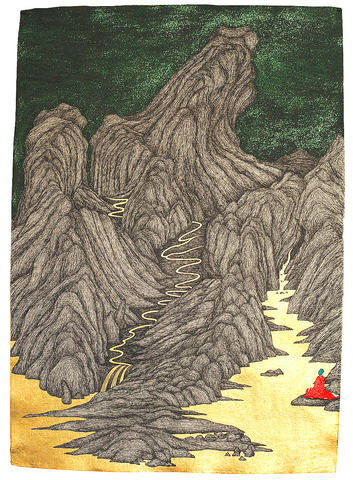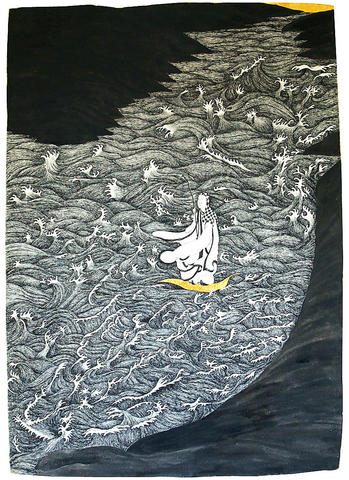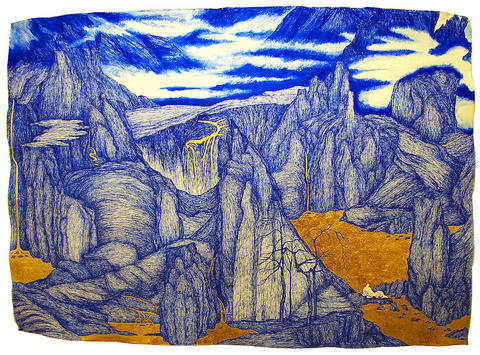The Glenfiddich Distillery, famed for its single malt scotch, is also home to one of the more innovative international artist residency programs, which began in 2002. It all started when the company wanted to establish a corporate art collection at the distillery.
The artist residency, which is located in the several empty houses on the distillery premises, provides funding, accommodation and studio space for eight artists every summer and stipulates that residents have to create an artwork for the collection. Artists are asked to draw inspiration from Glenfiddich's brew and the local environment.
Taiwanese artist Yao Jui-chung (姚瑞中) spent his three-month residency creating mainly ink drawings combined with gold leaf on handmade paper. The framed results are on display at the IT Park until Dec. 8

PHOTOS:COURTESY OF YAO JUI-CHUNG
The exhibition opening last week at the IT Park was attended by the residency's director, clad in a kilt and sporting dreadlocks.
The residency - located in Dufftown, Scotland, with a population of 2,000 - was a contrast to the hectic pace of Taipei life, which Yao is used to. The artist, who is well-known in the capital's art circle, helps run the nearby VT Art Salon, has published several books, makes videos, photos and drawings and teaches at a university. The Scottish town's slow pace and the country's pre-Christian roots sparked Yao's frenetic burst of creativity.
The drawings include depictions of Yao's hobbies - bathing in hot springs, mountain climbing, appreciating nature, playing chess - while referring to classical Chinese painting from the late Ming Dynasty.

PHOTOS:COURTESY OF YAO JUI-CHUNG
Yao's previous work took a critical view of Taiwan's turbulent political and social situation. In his new works, he has continued painting his dog-faced characters, which represent cynics and devils. Yet, these drawings seem to be the weakest of the series, perhaps because they illustrate the contentious dichotomy of local politics and lose any poetic feeling.
Yao's strongest drawings are those that reference Scottish mythology, ancient Pictish stone circles, the dramatic Scottish highlands and Chinese landscape painting.
Wonderful: The Holy Ridge under the Milk-way, a figuratively-shaped mountain that is formed by intensely worked black ink scribbles, shows the artist's erratic, quick-handed movements. Gold leaf rivulets stream forth from mysterious inner mountain sources. This huge mountain range dwarfs a red-cloaked figure who appears to be at one with nature, enjoying the heavenliness of the scene.

PHOTOS:COURTESY OF YAO JUI-CHUNG
Graphically, Wonderful: Crossing the Taiwan Strait by a Leaf is a perfect work of art. White crested waves grasping the air like greedy hands are finely delineated in black lines and carry a delicate Buddha-like figure on a small gold leaf.
The mystical Wonderful: Looking the Waterfall in Tain-Da-Na is a good example of Yao's merging of Scottish and Chinese landscapes. It feels like a real place, but also a dreamlike, imaginary landscape.
Yao, who abandoned the classical for the avant-garde, was pleasantly surprised to rediscover the richness of traditional art. It was his studied knowledge of the past that helped him create something new. And that is probably one of the best reasons to have an artist residency program. I'll drink to that.

On April 26, The Lancet published a letter from two doctors at Taichung-based China Medical University Hospital (CMUH) warning that “Taiwan’s Health Care System is on the Brink of Collapse.” The authors said that “Years of policy inaction and mismanagement of resources have led to the National Health Insurance system operating under unsustainable conditions.” The pushback was immediate. Errors in the paper were quickly identified and publicized, to discredit the authors (the hospital apologized). CNA reported that CMUH said the letter described Taiwan in 2021 as having 62 nurses per 10,000 people, when the correct number was 78 nurses per 10,000

As we live longer, our risk of cognitive impairment is increasing. How can we delay the onset of symptoms? Do we have to give up every indulgence or can small changes make a difference? We asked neurologists for tips on how to keep our brains healthy for life. TAKE CARE OF YOUR HEALTH “All of the sensible things that apply to bodily health apply to brain health,” says Suzanne O’Sullivan, a consultant in neurology at the National Hospital for Neurology and Neurosurgery in London, and the author of The Age of Diagnosis. “When you’re 20, you can get away with absolute

May 5 to May 11 What started out as friction between Taiwanese students at Taichung First High School and a Japanese head cook escalated dramatically over the first two weeks of May 1927. It began on April 30 when the cook’s wife knew that lotus starch used in that night’s dinner had rat feces in it, but failed to inform staff until the meal was already prepared. The students believed that her silence was intentional, and filed a complaint. The school’s Japanese administrators sided with the cook’s family, dismissing the students as troublemakers and clamping down on their freedoms — with

As Donald Trump’s executive order in March led to the shuttering of Voice of America (VOA) — the global broadcaster whose roots date back to the fight against Nazi propaganda — he quickly attracted support from figures not used to aligning themselves with any US administration. Trump had ordered the US Agency for Global Media, the federal agency that funds VOA and other groups promoting independent journalism overseas, to be “eliminated to the maximum extent consistent with applicable law.” The decision suddenly halted programming in 49 languages to more than 425 million people. In Moscow, Margarita Simonyan, the hardline editor-in-chief of the